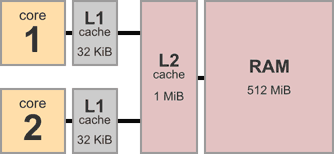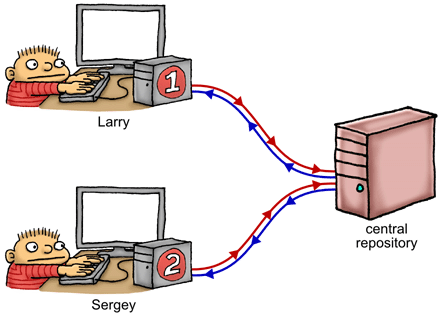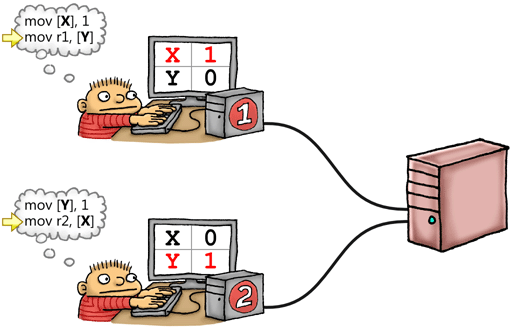Memory Barriers Are Like Source Control Operations
From: http://preshing.com/20120710/memory-barriers-are-like-source-control-operations/
If you use source control, you’re on your way towards understanding memory ordering, an important consideration when writing lock-free code in C, C++ and other languages.
In my last post, I wrote about memory ordering at compile time, which forms one half of the memory ordering puzzle. This post is about the other half: memory ordering at runtime, on the processor itself. Like compiler reordering, processor reordering is invisible to a single-threaded program. It only becomes apparent when lock-free techniques are used – that is, when shared memory is manipulated without any mutual exclusion between threads. However, unlike compiler reordering, the effects of processor reordering are only visible in multicore and multiprocessor systems.
You can enforce correct memory ordering on the processor by issuing any instruction which acts as a memory barrier. In some ways, this is the only technique you need to know, because when you use such instructions, compiler ordering is taken care of automatically. Examples of instructions which act as memory barriers include (but are not limited to) the following:
- Certain inline assembly directives in GCC, such as the PowerPC-specific
asm volatile("lwsync" ::: "memory") - Any Win32 Interlocked operation, except on Xbox 360
- Many operations on C++11 atomic types, such as
load(std::memory_order_acquire) - Operations on POSIX mutexes, such as
pthread_mutex_lock
Just as there are many instructions which act as memory barriers, there are many different types of memory barriers to know about. Indeed, not all of the above instructions produce the same kind of memory barrier – leading to another possible area of confusion when writing lock-free code. In an attempt to clear things up to some extent, I’d like to offer an analogy which I’ve found helpful in understanding the vast majority (but not all) of possible memory barrier types.
To begin with, consider the architecture of a typical multicore system. Here’s a device with two cores, each having 32 KiB of private L1 data cache. There’s 1 MiB of L2 cache shared between both cores, and 512 MiB of main memory.

A multicore system is a bit like a group of programmers collaborating on a project using a bizarre kind of source control strategy. For example, the above dual-core system corresponds to a scenario with just two programmers. Let’s name them Larry and Sergey.

On the right, we have a shared, central repository – this represents a combination of main memory and the shared L2 cache. Larry has a complete working copy of the repository on his local machine, and so does Sergey – these (effectively) represent the L1 caches attached to each CPU core. There’s also a scratch area on each machine, to privately keep track of registers and/or local variables. Our two programmers sit there, feverishly editing their working copy and scratch area, all while making decisions about what to do next based on the data they see – much like a thread of execution running on that core.
Which brings us to the source control strategy. In this analogy, the source control strategy is very strange indeed. As Larry and Sergey modify their working copies of the repository, their modifications are constantly leaking in the background, to and from the central repository, at totally random times. Once Larry edits the file X, his change will leak to the central repository, but there’s no guarantee about when it will happen. It might happen immediately, or it might happen much, much later. He might go on to edit other files, say Y and Z, and those modifications might leak into the respository before X gets leaked. In this manner, stores are effectively reordered on their way to the repository.
Similarly, on Sergey’s machine, there’s no guarantee about the timing or the order in which those changes leak back from the repository into his working copy. In this manner, loads are effectively reordered on their way out of the repository.
Now, if each programmer works on completely separate parts of the repository, neither programmer will be aware of these background leaks going on, or even of the other programmer’s existence. That would be analogous to running two independent, single-threaded processes. In this case, the cardinal rule of memory ordering is upheld.
The analogy becomes more useful once our programmers start working on the same parts of the repository. Let’s revisit the example I gave in an earlier post. X and Y are global variables, both initially 0:

Think of X and Y as files which exist on Larry’s working copy of the repository, Sergey’s working copy, and the central repository itself. Larry writes 1 to his working copy of X and Sergey writes 1 to his working copy of Y at roughly the same time. If neither modification has time to leak to the repository and back before each programmer looks up his working copy of the other file, they’ll end up with both r1 = 0 and r2 = 0. This result, which may have seemed counterintuitive at first, actually becomes pretty obvious in the source control analogy.

Types of Memory Barrier
Fortunately, Larry and Sergey are not entirely at the mercy of these random, unpredictable leaks happening in the background. They also have the ability to issue special instructions, called fence instructions, which act as memory barriers. For this analogy, it’s sufficient to define four types of memory barrier, and thus four different fence instructions. Each type of memory barrier is named after the type of memory reordering it’s designed to prevent: for example, #StoreLoad is designed to prevent the reordering of a store followed by a load.

As Doug Lea points out, these four categories map pretty well to specific instructions on real CPUs – though not exactly. Most of the time, a real CPU instruction acts as some combination of the above barrier types, possibly in addition to other effects. In any case, once you understand these four types of memory barriers in the source control analogy, you’re in a good position to understand a large number of instructions on real CPUs, as well as several higher-level programming language constructs.
#LoadLoad
A LoadLoad barrier effectively prevents reordering of loads performed before the barrier with loads performed after the barrier.
In our analogy, the #LoadLoad fence instruction is basically equivalent to a pull from the central repository. Think git pull, hg pull, p4 sync, svn update or cvs update, all acting on the entire repository. If there are any merge conflicts with his local changes, let’s just say they’re resolved randomly.

Mind you, there’s no guarantee that #LoadLoad will pull the latest, or head, revision of the entire repository! It could very well pull an older revision than the head, as long as that revision is at least as new as the newest value which leaked from the central repository into his local machine.
This may sound like a weak guarantee, but it’s still a perfectly good way to prevent seeing stale data. Consider the classic example, where Sergey checks a shared flag to see if some data has been published by Larry. If the flag is true, he issues a #LoadLoad barrier before reading the published value:
if (IsPublished) // Load and check shared flag
{
LOADLOAD_FENCE(); // Prevent reordering of loads
return Value; // Load published value
}
Obviously, this example depends on having the IsPublished flag leak into Sergey’s working copy by itself. It doesn’t matter exactly when that happens; once the leaked flag has been observed, he issues a #LoadLoad fence to prevent reading some value of Value which is older than the flag itself.
#StoreStore
A StoreStore barrier effectively prevents reordering of stores performed before the barrier with stores performed after the barrier.
In our analogy, the #StoreStore fence instruction corresponds to a push to the central repository. Think git push, hg push, p4 submit, svn commit or cvs commit, all acting on the entire repository.

As an added twist, let’s suppose that #StoreStore instructions are not instant. They’re performed in a delayed, asynchronous manner. So, even though Larry executes a #StoreStore, we can’t make any assumptions about when all his previous stores finally become visible in the central repository.
This, too, may sound like a weak guarantee, but again, it’s perfectly sufficient to prevent Sergey from seeing any stale data published by Larry. Returning to the same example as above, Larry needs only to publish some data to shared memory, issue a #StoreStore barrier, then set the shared flag to true:
Value = x; // Publish some data
STORESTORE_FENCE();
IsPublished = 1; // Set shared flag to indicate availability of data
Again, we’re counting on the value of IsPublished to leak from Larry’s working copy over to Sergey’s, all by itself. Once Sergey detects that, he can be confident he’ll see the correct value of Value. What’s interesting is that, for this pattern to work, Value does not even need to be an atomic type; it could just as well be a huge structure with lots of elements.
#LoadStore
 Unlike
Unlike #LoadLoad and #StoreStore, there’s no clever metaphor for #LoadStore in terms of source control operations. The best way to understand a #LoadStore barrier is, quite simply, in terms of instruction reordering.
Imagine Larry has a set of instructions to follow. Some instructions make him load data from his private working copy into a register, and some make him store data from a register back into the working copy. Larry has the ability to juggle instructions, but only in specific cases. Whenever he encounters a load, he looks ahead at any stores that are coming up after that; if the stores are completely unrelated to the current load, then he’s allowed to skip ahead, do the stores first, then come back afterwards to finish up the load. In such cases, the cardinal rule of memory ordering – never modify the behavior of a single-threaded program – is still followed.
On a real CPU, such instruction reordering might happen on certain processors if, say, there is a cache miss on the load followed by a cache hit on the store. But in terms of understanding the analogy, such hardware details don’t really matter. Let’s just say Larry has a boring job, and this is one of the few times when he’s allowed to get creative. Whether or not he chooses to do it is completely unpredictable. Fortunately, this is a relatively inexpensive type of reordering to prevent; when Larry encounters a #LoadStore barrier, he simply refrains from such reordering around that barrier.
In our analogy, it’s valid for Larry to perform this kind of LoadStore reordering even when there is a #LoadLoad or #StoreStore barrier between the load and the store. However, on a real CPU, instructions which act as a #LoadStore barrier typically act as at least one of those other two barrier types.
#StoreLoad
A StoreLoad barrier ensures that all stores performed before the barrier are visible to other processors, and that all loads performed after the barrier receive the latest value that is visible at the time of the barrier. In other words, it effectively prevents reordering of all stores before the barrier against all loads after the barrier, respecting the way a sequentially consistent multiprocessor would perform those operations.
#StoreLoad is unique. It’s the only type of memory barrier that will prevent the result r1 = r2 = 0 in the example given in Memory Reordering Caught in the Act; the same example I’ve repeated earlier in this post.
If you’ve been following closely, you might wonder: How is #StoreLoad different from a #StoreStorefollowed by a #LoadLoad? After all, a #StoreStore pushes changes to the central repository, while #LoadLoad pulls remote changes back. However, those two barrier types are insufficient. Remember, the push operation may be delayed for an arbitrary number of instructions, and the pull operation might not pull from the head revision. This hints at why the PowerPC’s lwsync instruction – which acts as all three #LoadLoad, #LoadStore and #StoreStore memory barriers, but not #StoreLoad – is insufficient to prevent r1 = r2 = 0 in that example.
In terms of the analogy, a #StoreLoad barrier could be achieved by pushing all local changes to the central repostitory, waiting for that operation to complete, then pulling the absolute latest head revision of the repository. On most processors, instructions that act as a #StoreLoad barrier tend to be more expensive than instructions acting as the other barrier types.

If we throw a #LoadStore barrier into that operation, which shouldn’t be a big deal, then what we get is a full memory fence – acting as all four barrier types at once. As Doug Lea also points out, it just so happens that on all current processors, every instruction which acts as a #StoreLoad barrier also acts as a full memory fence.
How Far Does This Analogy Get You?
As I’ve mentioned previously, every processor has different habits when it comes to memory ordering. The x86/64 family, in particular, has a strong memory model; it’s known to keep memory reordering to a minimum. PowerPC and ARM have weaker memory models, and the Alpha is famous for being in a league of its own. Fortunately, the analogy presented in this post corresponds to a weak memory model. If you can wrap your head around it, and enforce correct memory ordering using the fence instructions given here, you should be able to handle most CPUs.
The analogy also corresponds pretty well to the abstract machine targeted by both C++11 (formerly known as C++0x) and C11. Therefore, if you write lock-free code using the standard library of those languages while keeping the above analogy in mind, it’s more likely to function correctly on any platform.
In this analogy, I’ve said that each programmer represents a single thread of execution running on a separate core. On a real operating system, threads tend to move between different cores over the course of their lifetime, but the analogy still works. I’ve also alternated between examples in machine language and examples written in C/C++. Obviously, we’d prefer to stick with C/C++, or another high-level language; this is possible because again, any operation which acts as a memory barrier also prevents compiler reordering.
I haven’t written about every type of memory barrier yet. For instance, there are also data dependency barriers. I’ll describe those further in a future post. Still, the four types given here are the big ones.
If you’re interested in how CPUs work under the hood – things like stores buffers, cache coherency protocols and other hardware implementation details – and why they perform memory reordering in the first place, I’d recommend the fine work of Paul McKenney & David Howells. Indeed, I suspect most programmers who have successfully written lock-free code have at least a passing familiarity with such hardware details.
Memory Barriers Are Like Source Control Operations的更多相关文章
- Synthesis of memory barriers
A framework is provided for automatic inference of memory fences in concurrent programs. A method is ...
- Visual Studio 2013 always switches source control plugin to Git and disconnect TFS
A few days ago, I've been facing a strange behavior with Visual Studio 2013. No matter what solu ...
- 错误解决:SharePoint Designer 2010编辑后,出现数据源控件未能执行插入命令,data source control failed to execute the insert command
打了SharePoint 2010 最新的SP 2的补丁,但是使用SharePoint Designer 2010 定义任何一个列表的“插入视图”时,总是出现标题那样的错误: 数据源控件未能执行插入命 ...
- Why is applicationhost.config still being added to source control even thought it's in gitignore
Why is applicationhost.config still being added to source control even thought it's in gitignore g ...
- 小白也能用Git管理团队项目了:百度云同步+Git Extensions+Git Source Control Provider
百度云同步 百度云同步,会将本地的某个文件目录和云端进行同步.如果在本地将这个同步的目录设置为Git的中心服务器,那么本地push到中心服务器的内容也会被同步到云端.其他开发者只要也进行相同的设置,就 ...
- Using NuGet without committing packages to source control(在没有把包包提交到代码管理器的情况下使用NuGet进行还原 )
外国老用的语言就是谨慎,连场景都限定好了,其实我们经常下载到有用NuGet引用包包然而却没法编译的情况,上谷歌百度搜又没法使用准确的关键字,最多能用到的就是nuget跟packages.config, ...
- 不同的source control下配置DiffMerge
TFS: 1. 打开Option -> Source Control -> Visual Studio TFS -> Configure User Tools; 2. 添加 .*, ...
- Git使用过程中出现项目文件无法签入Source Control的情况
在VS中使用Git进行项目source control的过程中,有些文件不在source control之下,右键点击时,也找不到Undo, Commit命令 无法把他们签入进Source Contr ...
- 【转】使用XCODE 的SOURCE CONTROL 做版本控制 (1)
原文网址:http://it.zhaozhao.info/archives/60469 有一次笔者在开心项目准备尝试新的练习的时候,赫然注意到在选择档案存放位置的时候,下面有个Source Contr ...
随机推荐
- 【优化算法】变邻域搜索算法解决0-1背包问题(Knapsack Problem)代码实例 已
01 前言 经过小编这几天冒着挂科的风险,日日修炼,终于赶在考试周中又给大家更新了一篇干货文章.关于用变邻域搜索解决0-1背包问题的代码.怎样,大家有没有很感动? 02 什么是0-1背包问题? 0-1 ...
- 第四组团队git现场编程实战
组员职责分工 组员 分工 林涛(组长) 分配任务.整理数据.写博客 童圣滔 UI界面制作 林红莲 UI界面制作 潘雨佳 测评出福州最受欢迎的商圈 于瀚翔 测评出福州最受欢迎的商圈 覃鸿浩 测评出福州人 ...
- 获取Linux系统运行时间
uptime |sed 's/^.*up//' |sed 's/users.*//g'|awk '{for(i=1;i<NF;++i) printf $i "\t";prin ...
- 如何利用shell或者awk二维数组实现9x9乘法表?
第一种:利用shell for循环来实现. for i in `seq 1 9`do for j in `seq 1 9` do if [ $i -ge $j ] then echo -en &quo ...
- Lucene核心数据结构——FST存词典,跳表存倒排或者roarning bitmap 见另外一个文章
Lucene实现倒排表没有使用bitmap,为了效率,lucene使用了一些策略,具体如下:1. 使用FST保存词典,FST可以实现快速的Seek,这种结构在当查询可以表达成自动机时(PrefixQu ...
- jquery报变量没定义错误的原因
该变量定义的范围:不在使用的方法中:
- base64和hex
base64和hex 我们知道,字符分为二种:一种是可见字符:另一种是不可见字符. 1)三种编码方式 hex也称为base16,意思是使用16个可见字符来表示一个二进制数组,编码后数据大小将翻倍,因为 ...
- Docker学习知识图
这个图更能明白他们之间的关系 文章来源:外星人来地球 欢迎关注,有问题一起学习欢迎留言.评论
- Linux中显示系统中USB信息的lsusb命令
来源:Linux中国 原文:https://linux.cn/article-2448-1.html 通用串行总线(USB)被设计成为连接计算机外设的标准,如键盘.鼠标.打印机.数码相机.便携式媒体 ...
- OpenJudge计算概论-异常细胞检测
/*======================================================================== 异常细胞检测 总时间限制: 1000ms 内存限制 ...
